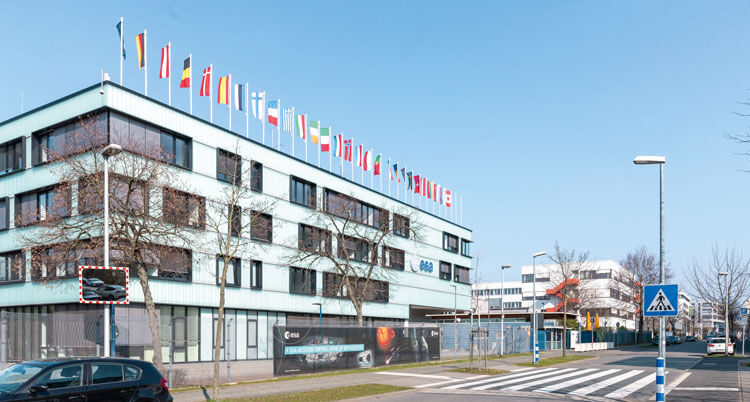The scope of services of M&P
- Refitting of utility building with a focus on energy efficiency and climate neutrality
- Creation of a new supply concept with three pillars: hybrid heat pump system with sources of outside air and cooling water
- Reversible heat pump system that provides heating and cooling
- Bivalent heating system: two additional gas condensing boilers for peak load and as a redundant system
- Additional decentralised hot-water supply for two buildings through solar thermal energy
The ESOC is Europe’s ‘gateway to space’. Since 1967, satellites have been operationally supervised in the control centre immediately after launch into orbit. By newly equipping the utility building, M&P is ensuring a meteoric rise in energy savings in the centre itself.
The ESOC in Darmstadt is responsible for the satellite operations of the European Space Agency (ESA). The ESA Space Security Programme is also based in the Hessian ‘Science City’. Specialists there are responsible for the observation, discovery and prediction of possible risks from objects or natural phenomena in space. Since 1967, the ESOC has operated over 100 satellites, providing researchers with important data on everything from the origin of the universe to climate change.
In order not to lose contact with any of the satellites and to ensure the best possible working conditions in the control rooms, the building technology must be 100% fail-safe. Nobody in Darmstadt would say that is still guaranteed. ‘The buildings are from 1967. An old utility building housed the heating centre, cooling centre and a large part of the electrical supply. Renovation was badly needed, not least because the centre is now focused on sustainability and carbon neutrality. The management commissioned M&P to create a future-ready supply concept that meets the requirements for safety as well as energy efficiency and climate neutrality,’ says Niklas, the responsible project engineer from the M&P Energy team.
Refitting the utility building: room for astronomical energy savings
Our Energy team immediately got to work. The first step: analysis of the heating and cooling consumption on-site. The result showed that the four existing boilers had two to three times more output power than needed. That meant huge potential for greater energy efficiency. M&P is currently doing everything it can to leverage that.
The M&P Energy team’s concept for the ESOC’s utility building is based on three pillars:
- A hybrid heat pump system with sources of outside air and cooling water
- A reversible heat pump system that provides both heating and cooling
- A bivalent heating system: two additional gas condensing boilers for peak load and as a redundant system
What does all that jargon mean? Niklas explains: ‘In the old utility building, there were four gas boilers to provide heating energy. At the same time, there were cooling units for the data centres, for example. Both systems worked completely independently of each other. And quite inefficiently. The cooling units released their waste heat into the environment via cooling towers on the roof. From an energy point of view, there is a far more logical alternative: our concept combines both systems. We use the waste heat from the cooling units for the heating system by means of a heat pump. The savings potential is huge; the heating energy is essentially free, so to speak. Heat pumps cover 90% of the energy requirement in a carbon-neutral manner. The old low-temperature boilers will be completely dismantled. However, we are integrating two new condensing boilers that provide support if temperatures dip particularly low during winter and serve as a redundant system. This concept of a connected, reversible system can be used anywhere that heating and cooling are needed all year round.’
At the ESOC, the M&P team is rounding off the realignment of the heating system with accompanying measures such as decentralised hot-water supply for two buildings with solar thermal energy, which makes it possible to switch off the entire heating network outside the heating period and reduce the flow temperatures. This measure alone is already saving 14% of the natural gas consumption.

Teamwork at M&P: out of this world
The astronomical savings for the ESOC are a real team effort by the M&P Group. The acquisition and concept were the responsibility of the Energy team. Our engineering experts are currently taking care of the planning order and implementation. bgis is also supporting the project with 3D planning in Revit. Our work for the ESOC is an outstanding example of how M&P uses expertise from all disciplines to put customer projects on an upward trajectory. The sky is no longer the limit.
